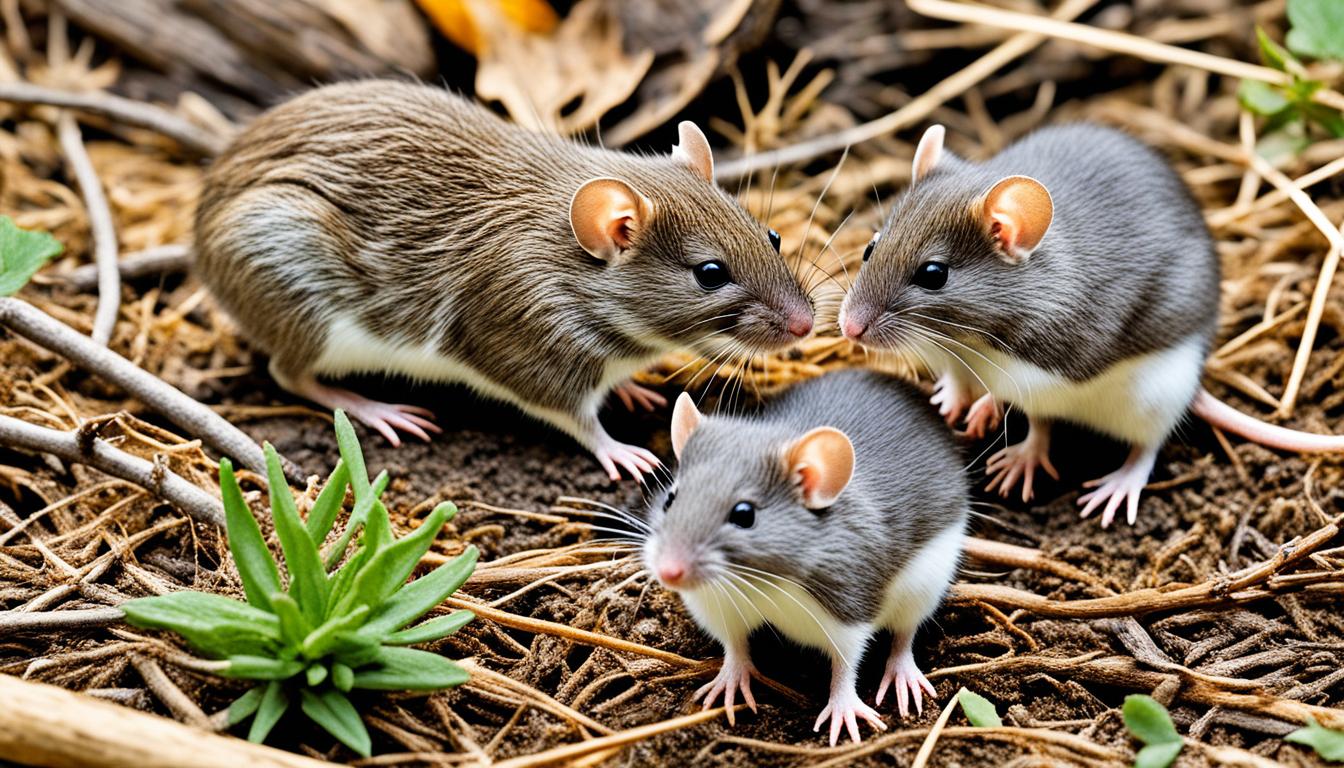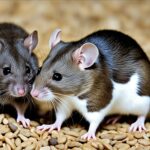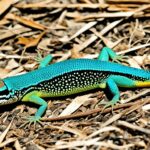Have you ever seen a small, furry animal in your garden and wondered if it’s a rat or a vole? It’s common to mix them up. But knowing the differences is key to dealing with them. Are you confident in telling the two apart?
It’s important to know how to spot a rat or a vole, for both homeowners and pest control experts. Although both can cause trouble, they have different habits and looks. Learning this makes it easier to choose the right way to handle them. This article will help you get better at spotting the difference between rats and voles.
Understanding the Basic Differences: Rat vs Vole
It’s really important to know the physical and behavioral differences between rats and voles. This info helps you handle and stop infestations. Let’s look at their looks and how they act to learn to spot the differences.
General Appearance
Looking at them, you’ll notice big differences. Rats are bigger and have long bodies. Voles, on the other hand, are smaller and chunkier. Rats have sharp snouts, but voles have blunt ones. Also, rats’ ears are big and stand out, while voles’ ears are tiny and can be covered by fur.
Here’s a more detailed comparison:
| Feature | Rat | Vole |
|---|---|---|
| Body Size | Large and elongated | Small and stocky |
| Snout | Pointed | Blunt |
| Ears | Large and prominent | Small and hidden by fur |
Behavioral Traits
Rats and voles act very differently too. Rats love the city and are very good at living near people. They eat almost anything. Voles, however, enjoy outdoor places like gardens. They mainly eat plants.
Look at their activities and social life to spot more differences:
- Rats: Active at night and like being around others.
- Voles: Less active in daylight and live alone, making complex tunnels.
Knowing these facts about rats and voles, both in looks and actions, can help you manage them better.
Physical Characteristics of Rats
Knowing what rats look like is important to tell them apart from other rodents. They vary in size and have special body parts like the snout, ears, and tail. These parts stand out and make rats different from similar animals like voles.
Size and Body Structure
Rats are bigger than voles and mice. A grown-up rat is usually between 9 to 11 inches long, not counting the tail. The tail by itself can be 7 to 9 inches long. Rats have a slim, elongated body shape. This makes them look smooth. Spotting their larger size is a key way of identifying rats.
Appearance: Snout, Ears, and Tail
Here’s what makes a rat look like a rat:
- Snout: Rats have a sharp snout, unlike the rounder one of a vole.
- Ears: They have big ears, standing out from their face.
- Tail: Their tail is long, scaly, and as long as their body. This is a big hint in identifying rats, as voles have shorter tails.
Fur Color Variations
Rats can be many colors, making each one look unique. You might see them in brown, gray, white, or black. Their fur colors change to help them blend in, both in cities and the countryside. This can make identifying rats a bit tricky, depending on where they live.
Physical Characteristics of Voles
Identifying voles is easier when you know what makes them unique. We’ll look at their size, build, and how they look. This information is key in telling them apart from other rodents.
Size and Body Structure
Voles have a different shape than rats. They’re not as long and look more plump. They are usually between 3.5 to 9 inches long, tails included.
Their height and width stand out among other rodents. This makes them easy to spot.
Appearance: Snout, Ears, and Tail
One way to spot a vole is by its short, blunt snout. This is unlike rats, which have sharp, pointed noses. Voles’ ears are tiny, often partly covered by fur. Their tails are notably short compared to their body, which helps differentiate them from rats.
Fur Color Variations
Voles have fur that mixes chestnut brown and black. This makes them stand out from rodents like rats, which have more even fur. Paying attention to these fur colors helps spot voles in your area.
| Characteristic | Voles | Rats |
|---|---|---|
| Body Structure | Stockier, less elongated | Elongated, leaner |
| Snout | Blunt, rounded | Pointed |
| Ears | Smaller, less prominent | Larger, noticeable |
| Tail | Short, about one-third of body length | Longer, nearly equal to body length |
| Fur Color | Mixed chestnut brown and black | Uniform colors (brown, gray, black) |
Differences in Habitat Preferences
It’s key to know where rodents like to live for their management. Rats and voles choose different places to live, helping with telling them apart. Knowing this can make dealing with them easier.
Rats love cities because they can find food and shelter easily. You’ll often see them in homes, businesses, and sewers. They hang around these places because they find lots of food waste and places to hide.
Voles, on the other hand, enjoy the outdoors and shy away from cities. They make homes in open areas like fields, meadows, and forests. Voles cause trouble by digging tunnels and eating plant roots.
| Rodent | Preferred Habitat | Environment Attributes |
|---|---|---|
| Rats | Urban Areas | Close proximity to human activity, easy access to food and shelter |
| Voles | Outdoor Settings | Fields, meadows, woodlands, prone to creating tunnel systems |
Dietary Habits: Rat or Vole?
It’s important to know the eating habits of rats and voles to spot which one is around. This knowledge helps in dealing with them effectively. This way, you target your actions better.
Rats are very flexible in what they eat. They are omnivores, which means they can eat a lot of different things. This includes grains, fruits, and even meat. They also love getting into what we throw away, like in trash cans or compost piles. They are often seen near people’s homes just looking for food.
Voles, on the other hand, have a plant-based diet. They are herbivores. Their meals are mostly from plants, like grass, bulbs, and seeds. This is why you might find them mostly in outdoor places, especially where there’s a lot of greenery.
The next part will compare the diets of rats and voles more closely.
| Dietary Aspect | Rats | Voles |
|---|---|---|
| Primary Diet | Omnivorous: Includes grains, fruits, vegetables, meat, and waste | Herbivorous: Mainly grasses, bulbs, tubers, and seeds |
| Feeding Locations | Near human habitation, in urban settings, dumpsters, kitchens | In gardens, fields, grassy areas with abundant vegetation |
| Frequency and Variety | Frequent, varied diet due to opportunistic feeding habits | Consistent, vegetation-based diet, less variation |
| Behavior towards Food | Hoarders; may create food caches | Grazers; rarely hoard food |
Knowing the rat dietary habits and vole dietary habits helps you find out what’s going on at your place. Spotting the differences in what they eat is good for stopping them. It’s key for both keeping them away and getting rid of them.
Behavioral Patterns: Identifying Signs of Infestation
It’s vital to understand behavior patterns to spot a rodent infestation. We’ll look at signs showing a rat or vole might be nearby.

Signs of Rat Infestations
For rat infestation signs, keep an eye out for these clues:
- Droppings: Rat droppings are dark, elongated, and look like rice grains.
- Chew Marks: You might see gnaw marks on wood, plastic, and wires, which are dangerous.
- Rat Runs: Rats leave behind well-worn paths. Look for them near walls and buildings.
Signs of Vole Infestations
Identifying a vole infestation involves different signs. Keep an eye out for these indicators:
- Surface Tunneling: Voles make tunnels that show as raised ridges in lawns.
- Damaged Vegetation: Check for chewed or bearded plants near the ground, which is a telltale sign.
- Bark and Root Marks: Look for gnawing marks around the base of trees. This is a common vole activity.
| Indicators | Rats | Voles |
|---|---|---|
| Droppings | Dark, elongated | Pellet-like, smaller |
| Chew Marks | Present on wood, wires | Rare, mostly plants |
| Tunnel Systems | Not visible | Visible on lawns |
| Vegetation Damage | Minimal | Extensive |
Knowing rodent infestation identification signs is key. It helps you act early to handle and stop the infestation.
How do you distinguish between a rat and a vole?
The key to telling rats and voles apart lies in their details. Check their looks, where they live, what they eat, and how they act. This gives big hints.
Rats are bigger, have long bodies, and long tails. They also have big ears and sharp snouts. Voles are stocky with shorter tails and ears. Their snouts are more blunt than rats’. These differences are easy to spot.
Rats often live in towns and cities. They can be found close to people’s homes. Voles, on the other hand, love the outdoors. They like gardens and fields. They dig tunnels in these places. This is where they eat plants, their main food source.
- Appearance
- Size and Body Structure
- Snout, Ears, and Tail
- Fur Color Variations
- Habitat Preferences
- Urban areas (rats)
- Gardens and fields (voles)
- Dietary Habits
- Omnivorous (rats)
- Vegetation (voles)
Another clue to tell them apart is their signs. If you see droppings and food chewed up, it might be rats. Voles make tunnels on the ground. They also eat plants and damage gardens and trees.
| Characteristic | Rat | Vole |
|---|---|---|
| Body Size | Large, elongated | Stocky, smaller |
| Snout | Pointed | Blunt |
| Ear Size | Prominent | Less Prominent |
| Tail Length | Long | Short |
| Habitat | Urban, near humans | Outdoor, gardens |
| Diet | Omnivorous | Vegetation |
| Infestation Signs | Droppings, chew marks, rat runs | Surface tunnels, damaged vegetation |
Knowing these differences is key. It helps in figuring out the animal and how to control them. Different measures work best for rats and voles because they act differently and like different places.
Tips for Spotting Rats and Voles in Your Garden
Keeping your garden rat and vole-free means being very observant. You need to know what signs to look for. This can keep your garden safe from these pests.
First, check your plants for damage. Rats bite woody plants, leaving tooth marks. Voles dig tunnels under grass and bulbs. Seeing this damage helps you know what rodent is around.
Second, look for their paths. Rats make greasy marks and drop droppings where they walk. Voles leave clear trails in lawns and gardens. Finding these paths in different seasons can show you which rodent is there.
It’s easier to find rats because they come out at night, near dusk. Voles are harder to see but work in the day too. Keep an eye out for them when you’re gardening.
| Criteria | Rats | Voles |
|---|---|---|
| Type of Damage | Gnaw on woody plants, leave tooth marks | Target grasses and bulbs, create surface tunnels |
| Trails and Tracks | Greasy smudge marks, droppings on established pathways | Visible runways through lawns and gardens |
| Activity Time | Nocturnal (seen around dusk) | Active year-round, spotted during daytime |
Lastly, understanding these signs is key to fighting off garden rodents. Knowing what to watch for leads to better control. This keeps your garden in top shape, free from rats and voles.
Addressing Infestations: Prevention and Control Methods
Managing rodent infestations requires a mix of prevention and control steps. Start by making your property less attractive to these pests. Always check for ways they could enter and seal up any openings. Use strong materials to block off their access. Also, make sure your space is neat and clean. This makes it less likely for rodents to stick around.
To keep voles away, consider using certain smells that they dislike, like castor oil. You can put these around where you don’t want them to burrow. Setting up traps that don’t kill, called live traps, is another good step. And for your plants, you can shield them with wire above and below the ground. This tactic makes it tough for voles to get to the roots.
When dealing with rats, cut off their food and shelter. Keep your place super clean, and focus on places they might hide, like basements and attics. To trap them, use special stations and snap traps. If the rat problem is too big for you to handle alone, get help from professionals. Companies like Greenix Pest Control know how to take care of such pests. They offer services that are right for your situation. Plus, they work to stop rats from coming back, making your home safer.
FAQ
How do you distinguish between a rat and a vole?
What are the general appearance traits that distinguish a rat from a vole?
How do behavioral traits help in identifying rats and voles?
What are the notable physical characteristics of rats?
How can the appearance of a vole be described?
What are the key habitat preferences for rats and voles?
How do the dietary habits of rats and voles differ?
What are the signs of a rat infestation?
What signs indicate the presence of voles in your garden?
What are some practical tips for spotting rats and voles in your garden?
How can I prevent and control rat and vole infestations?
Source Links
- https://www.greenixpc.com/blog/how-to-tell-the-difference-between-a-mouse-rat-and-vole
- https://www.discoverwildlife.com/how-to/identify-wildlife/how-to-tell-the-difference-between-a-brown-rat-and-a-water-vole
- https://www.wwt.org.uk/news-and-stories/blog/how-to-tell-the-difference-between-water-voles-and-rats/










